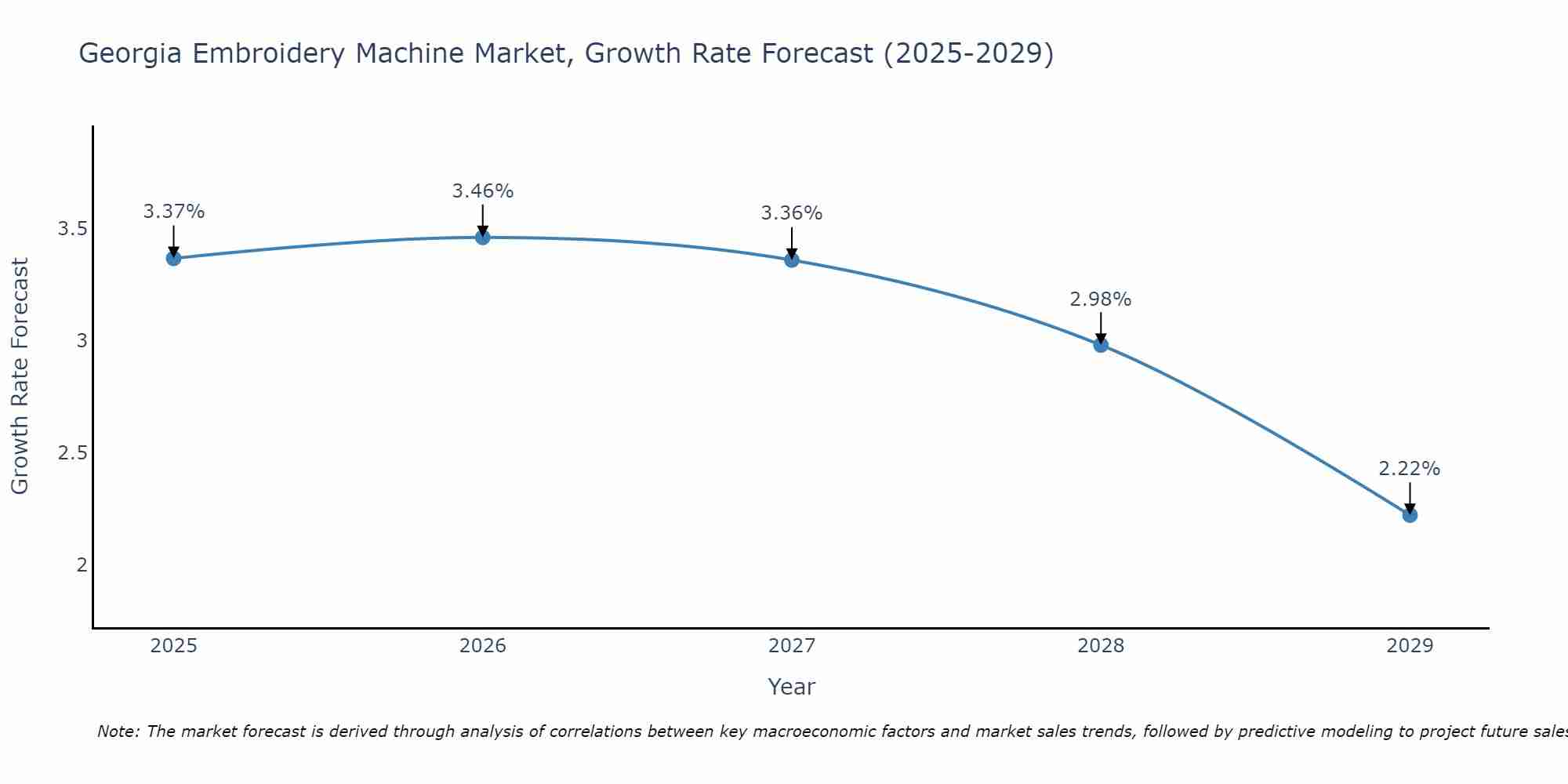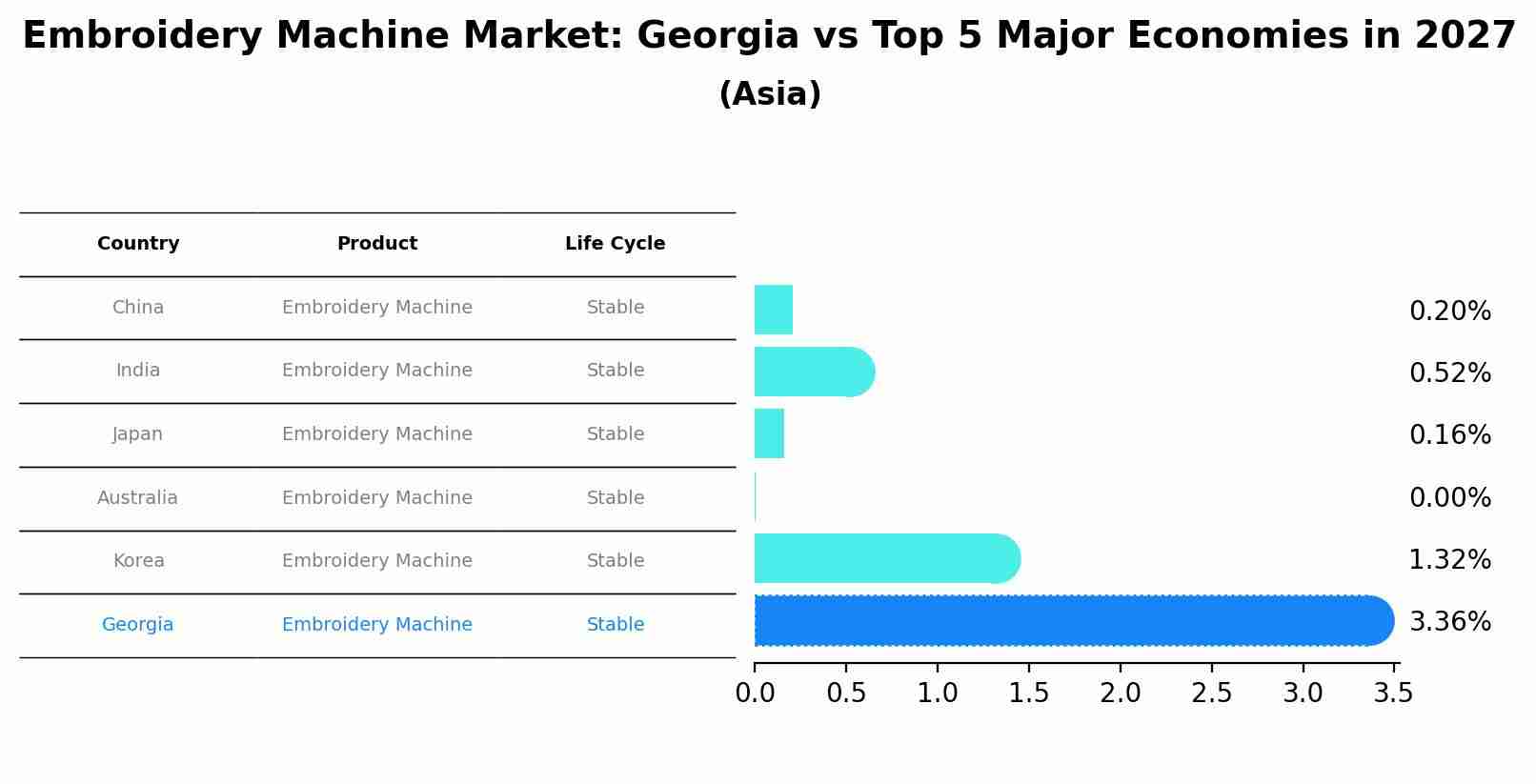Georgia Embroidery Machine Market (2025-2031) | Revenue, Share, Analysis, Forecast, Size, Companies, Industry, Trends, Outlook, Growth & Value
| Product Code: ETC063199 | Publication Date: Aug 2021 | Updated Date: Jun 2025 | Product Type: Report | |
| Publisher: 6Wresearch | Author: Summon Dutta | No. of Pages: 70 | No. of Figures: 35 | No. of Tables: 5 |
Georgia Embroidery Machine Market Size Growth Rate
The Georgia Embroidery Machine Market is projected to witness mixed growth rate patterns during 2025 to 2029. Growth accelerates to 3.46% in 2026, following an initial rate of 3.37%, before easing to 2.22% at the end of the period.

Embroidery Machine Market: Georgia vs Top 5 Major Economies in 2027 (Asia)
Georgia's Embroidery Machine market is anticipated to experience a stable growth rate of 3.36% by 2027, reflecting trends observed in the largest economy China, followed by India, Japan, Australia and South Korea.

Georgia Embroidery Machine Market Overview
The Georgia Embroidery Machine Market is a thriving sector within the state`s textile industry, driven by a growing demand for customized and unique embroidered products. With a strong presence of textile manufacturers and garment producers in Georgia, the market for embroidery machines has witnessed steady growth. Key players in the market offer a wide range of embroidery machines catering to both small-scale businesses and large manufacturing units. The market is characterized by technological advancements, such as computerized embroidery machines that offer precision and efficiency in design execution. Additionally, the market is influenced by factors like shifting consumer preferences towards personalized products and the increasing popularity of embroidered apparel and accessories. Overall, the Georgia Embroidery Machine Market presents opportunities for innovation and expansion in the textile sector.
Georgia Embroidery Machine Market Trends
The Georgia Embroidery Machine Market is experiencing a growing demand for multi-needle machines that offer increased efficiency and versatility for both commercial and personal use. Customers are seeking machines with advanced features such as automatic thread cutting, larger embroidery areas, and compatibility with digital designs. There is also a trend towards machines that are user-friendly, allowing beginners to easily learn and create intricate embroidery designs. Additionally, there is a rising interest in eco-friendly and sustainable embroidery machines that reduce waste and energy consumption. Overall, the market in Georgia is seeing a shift towards innovative technology and user-friendly designs to cater to the diverse needs of embroidery enthusiasts and businesses.
Georgia Embroidery Machine Market Challenges
The Georgia Embroidery Machine Market faces several challenges, including intense competition from both domestic and international manufacturers, rapid technological advancements leading to the need for continuous innovation, and fluctuations in raw material prices impacting production costs. Additionally, the market is influenced by changing consumer preferences and shifting trends in the fashion and textile industry, requiring companies to stay agile and responsive. Limited access to skilled labor and the rising costs of labor in the region also pose challenges for manufacturers in the Georgia Embroidery Machine Market. Overall, navigating these challenges requires companies to focus on product differentiation, cost efficiency, and strategic partnerships to remain competitive in the market.
Georgia Embroidery Machine Market Investment Opportunities
The Georgia Embroidery Machine Market presents various investment opportunities for both established companies and new entrants. With the growing demand for customized apparel, such as branded merchandise, uniforms, and personalized gifts, there is a rising need for advanced embroidery machines in the region. Investing in innovative embroidery technologies that offer faster production speeds, higher precision, and multi-function capabilities can be lucrative. Additionally, providing training and support services for businesses looking to incorporate embroidery in their offerings can be a profitable venture. Collaborating with local garment manufacturers, textile businesses, and e-commerce platforms to supply embroidery services can further expand market reach. Overall, investing in the Georgia Embroidery Machine Market offers potential for growth and profitability in an industry driven by customization and personalization trends.
Georgia Embroidery Machine Market Government Policy
Government policies related to the Georgia Embroidery Machine Market include regulations on import and export of embroidery machines, taxation policies, and labor laws affecting the industry. The Georgia government may offer incentives or subsidies to promote the growth of the embroidery machine market, as well as provide support for research and development activities in the sector. Additionally, there may be regulations in place regarding environmental sustainability and safety standards for manufacturing and operating embroidery machines in Georgia. Compliance with intellectual property rights and trade agreements may also impact the market. Overall, government policies play a crucial role in shaping the operating environment for companies in the Georgia Embroidery Machine Market, influencing aspects such as production costs, market competitiveness, and industry innovation.
Georgia Embroidery Machine Market Future Outlook
The Georgia embroidery machine market is poised for steady growth in the coming years due to the increasing demand for customized apparel and textile products. Technological advancements in embroidery machines, such as improved automation and digitization capabilities, are expected to drive market expansion. Additionally, the rising popularity of personalized and unique designs in the fashion industry is fueling the adoption of embroidery machines among small businesses and hobbyists. The market is also benefiting from the growing e-commerce sector, which provides a platform for entrepreneurs to sell their embroidered products globally. Overall, the Georgia embroidery machine market is forecasted to experience a positive trajectory, with opportunities for manufacturers to innovate and cater to the evolving needs of customers in the embroidery industry.
Key Highlights of the Report:
- Georgia Embroidery Machine Market Outlook
- Market Size of Georgia Embroidery Machine Market, 2021
- Forecast of Georgia Embroidery Machine Market, 2031
- Historical Data and Forecast of Georgia Embroidery Machine Revenues & Volume for the Period 2021 - 2031
- Georgia Embroidery Machine Market Trend Evolution
- Georgia Embroidery Machine Market Drivers and Challenges
- Georgia Embroidery Machine Price Trends
- Georgia Embroidery Machine Porter's Five Forces
- Georgia Embroidery Machine Industry Life Cycle
- Historical Data and Forecast of Georgia Embroidery Machine Market Revenues & Volume By Product Type for the Period 2021 - 2031
- Historical Data and Forecast of Georgia Embroidery Machine Market Revenues & Volume By Single Head for the Period 2021 - 2031
- Historical Data and Forecast of Georgia Embroidery Machine Market Revenues & Volume By Multi Head for the Period 2021 - 2031
- Historical Data and Forecast of Georgia Embroidery Machine Market Revenues & Volume By Applications for the Period 2021 - 2031
- Historical Data and Forecast of Georgia Embroidery Machine Market Revenues & Volume By Household for the Period 2021 - 2031
- Historical Data and Forecast of Georgia Embroidery Machine Market Revenues & Volume By Commercial for the Period 2021 - 2031
- Historical Data and Forecast of Georgia Embroidery Machine Market Revenues & Volume By Industrial for the Period 2021 - 2031
- Georgia Embroidery Machine Import Export Trade Statistics
- Market Opportunity Assessment By Product Type
- Market Opportunity Assessment By Applications
- Georgia Embroidery Machine Top Companies Market Share
- Georgia Embroidery Machine Competitive Benchmarking By Technical and Operational Parameters
- Georgia Embroidery Machine Company Profiles
- Georgia Embroidery Machine Key Strategic Recommendations
Frequently Asked Questions About the Market Study (FAQs):
1 Executive Summary |
2 Introduction |
2.1 Key Highlights of the Report |
2.2 Report Description |
2.3 Market Scope & Segmentation |
2.4 Research Methodology |
2.5 Assumptions |
3 Georgia Embroidery Machine Market Overview |
3.1 Georgia Country Macro Economic Indicators |
3.2 Georgia Embroidery Machine Market Revenues & Volume, 2021 & 2031F |
3.3 Georgia Embroidery Machine Market - Industry Life Cycle |
3.4 Georgia Embroidery Machine Market - Porter's Five Forces |
3.5 Georgia Embroidery Machine Market Revenues & Volume Share, By Product Type, 2021 & 2031F |
3.6 Georgia Embroidery Machine Market Revenues & Volume Share, By Applications, 2021 & 2031F |
4 Georgia Embroidery Machine Market Dynamics |
4.1 Impact Analysis |
4.2 Market Drivers |
4.3 Market Restraints |
5 Georgia Embroidery Machine Market Trends |
6 Georgia Embroidery Machine Market, By Types |
6.1 Georgia Embroidery Machine Market, By Product Type |
6.1.1 Overview and Analysis |
6.1.2 Georgia Embroidery Machine Market Revenues & Volume, By Product Type, 2018 - 2027F |
6.1.3 Georgia Embroidery Machine Market Revenues & Volume, By Single Head, 2018 - 2027F |
6.1.4 Georgia Embroidery Machine Market Revenues & Volume, By Multi Head, 2018 - 2027F |
6.2 Georgia Embroidery Machine Market, By Applications |
6.2.1 Overview and Analysis |
6.2.2 Georgia Embroidery Machine Market Revenues & Volume, By Household, 2018 - 2027F |
6.2.3 Georgia Embroidery Machine Market Revenues & Volume, By Commercial, 2018 - 2027F |
6.2.4 Georgia Embroidery Machine Market Revenues & Volume, By Industrial, 2018 - 2027F |
7 Georgia Embroidery Machine Market Import-Export Trade Statistics |
7.1 Georgia Embroidery Machine Market Export to Major Countries |
7.2 Georgia Embroidery Machine Market Imports from Major Countries |
8 Georgia Embroidery Machine Market Key Performance Indicators |
9 Georgia Embroidery Machine Market - Opportunity Assessment |
9.1 Georgia Embroidery Machine Market Opportunity Assessment, By Product Type, 2021 & 2031F |
9.2 Georgia Embroidery Machine Market Opportunity Assessment, By Applications, 2021 & 2031F |
10 Georgia Embroidery Machine Market - Competitive Landscape |
10.1 Georgia Embroidery Machine Market Revenue Share, By Companies, 2021 |
10.2 Georgia Embroidery Machine Market Competitive Benchmarking, By Operating and Technical Parameters |
11 Company Profiles |
12 Recommendations |
13 Disclaimer |
- Single User License$ 1,995
- Department License$ 2,400
- Site License$ 3,120
- Global License$ 3,795
Search
Thought Leadership and Analyst Meet
Our Clients
Related Reports
- Afghanistan Apparel Market (2026-2032) | Growth, Outlook, Industry, Segmentation, Forecast, Size, Companies, Trends, Value, Share, Analysis & Revenue
- Canada Oil and Gas Market (2026-2032) | Share, Segmentation, Value, Industry, Trends, Forecast, Analysis, Size & Revenue, Growth, Competitive Landscape, Outlook, Companies
- Germany Breakfast Food Market (2026-2032) | Industry, Share, Growth, Size, Companies, Value, Analysis, Revenue, Trends, Forecast & Outlook
- Australia Briquette Market (2025-2031) | Growth, Size, Revenue, Forecast, Analysis, Trends, Value, Share, Industry & Companies
- Vietnam System Integrator Market (2025-2031) | Size, Companies, Analysis, Industry, Value, Forecast, Growth, Trends, Revenue & Share
- ASEAN and Thailand Brain Health Supplements Market (2025-2031) | Strategy, Consumer Insights, Analysis, Investment Trends, Opportunities, Growth, Size, Share, Industry, Revenue, Segments, Value, Segmentation, Supply, Forecast, Restraints, Outlook, Competition, Drivers, Trends, Demand, Pricing Analysis, Competitive, Strategic Insights, Companies, Challenges
- ASEAN Bearings Market (2025-2031) | Strategy, Consumer Insights, Analysis, Investment Trends, Opportunities, Growth, Size, Share, Industry, Revenue, Segments, Value, Segmentation, Supply, Forecast, Restraints, Outlook, Competition, Drivers, Trends, Demand, Pricing Analysis, Competitive, Strategic Insights, Companies, Challenges
- Europe Flooring Market (2025-2031) | Outlook, Share, Industry, Trends, Forecast, Companies, Revenue, Size, Analysis, Growth & Value
- Saudi Arabia Manlift Market (2025-2031) | Outlook, Size, Growth, Trends, Companies, Industry, Revenue, Value, Share, Forecast & Analysis
- Uganda Excavator, Crane, and Wheel Loaders Market (2025-2031) | Strategy, Consumer Insights, Analysis, Investment Trends, Opportunities, Growth, Size, Share, Industry, Revenue, Segments, Value, Segmentation, Supply, Forecast, Restraints, Outlook, Competition, Drivers, Trends, Demand, Pricing Analysis, Competitive, Strategic Insights, Companies, Challenges
Industry Events and Analyst Meet
Whitepaper
- Middle East & Africa Commercial Security Market Click here to view more.
- Middle East & Africa Fire Safety Systems & Equipment Market Click here to view more.
- GCC Drone Market Click here to view more.
- Middle East Lighting Fixture Market Click here to view more.
- GCC Physical & Perimeter Security Market Click here to view more.
6WResearch In News
- Doha a strategic location for EV manufacturing hub: IPA Qatar
- Demand for luxury TVs surging in the GCC, says Samsung
- Empowering Growth: The Thriving Journey of Bangladesh’s Cable Industry
- Demand for luxury TVs surging in the GCC, says Samsung
- Video call with a traditional healer? Once unthinkable, it’s now common in South Africa
- Intelligent Buildings To Smooth GCC’s Path To Net Zero


















